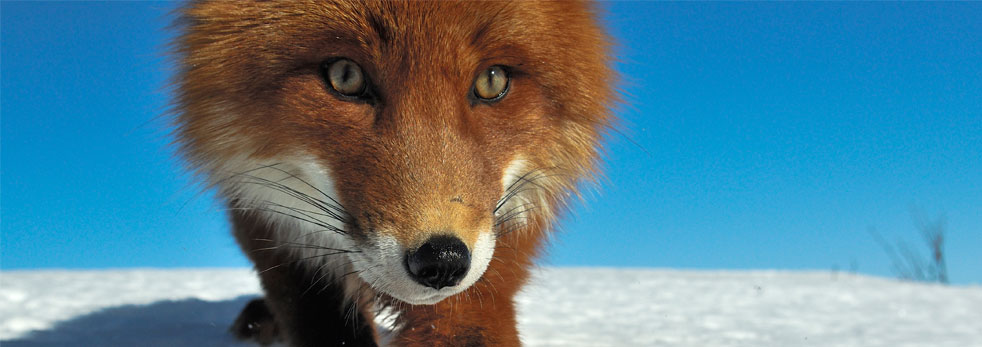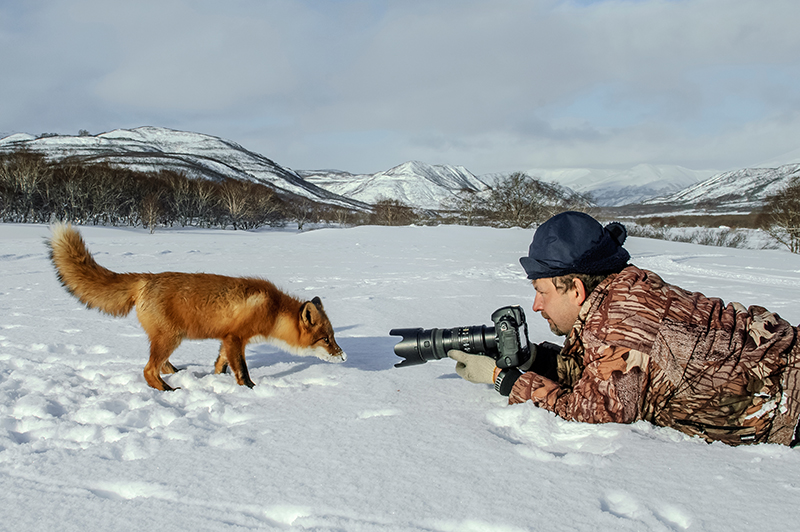
Sergey Gorshkov who now lives in Moscow is one of Russia’s leading wildlife photographers. For many years Sergey Sergey has photographed wild nature. Every year his feeling of alarm has grown. The world, which he photographs, is in danger now. Kamchatka is Sergey’s favorite place of shooting. “Travelling through the world of the wild nature of Kamchatka is so fascinating and amazing that many years of work have gone by seemingly as one single day. I am happy that I had an opportunity to observe the beauty of fauna of this peninsula. Memoirs, which I have got here, will remain with me all my life...” - Sergey says.
He thinks that each photographer should have an individual project, which he should know and develop. Sergey’s photography is focused on the wild world of Kamchatka, to be exact the wild world of a bear.
web page: www.gorshkov-photo.com
Facebook: www.facebook.com/gorshkov.photo

How did it all start? Let’s begin with the story of the wildlife photographer in you. How do you perceive the beauty of nature in your fabulous images?
Initially, I was engaged in trophy hunting. I traveled all over the world. I was eager to get a trophy with horns two centimetres bigger than the world record. But then I picked up the camera - and it was much more interesting for me. When I first saw a leopard, I could not shoot him, put off the shotgun and started clicking. At this point, and that was the tipping point, I realized that I should not intrude into their lives. A pair of leopards playing nearby was lot more fun to watch and photograph than to shoot with a gun and hang a trophy horn on the wall. In Africa, I got attached to photography forever, but I do not consider myself a professional photographer. I have a lot of hobbies and it is not my means of livelihood. I actually spend more money on photography. For me it is spiritual food and hobby, to which I give most of my free time and get great pleasure, being in communion with nature. I plan every trip in advance, gather a lot of information from friends and then build my plans.
Do you have a favorite model among animals?
Yes, My beloved African model - a leopard in Botswana and in Kamchatka - bears and Steller’s sea eagle, a beautiful bird that lives only in Russia. The eagles fly to Japan in winter, but only breeds on the eastern coast of Kamchatka and along the coast of the Sea of Okhotsk.Now there are about 2,500 pairs worldwide, and all of them live with us in Russia. The eagles are incredibly beautiful birds and very diffcult to photograph. I have spent five years to get good pictures of them. This bird is very shy but incredibly photogenic.
Your view on wild animal - human conflicts or interactions?
I come from an area where wild animals live in abundance. They exhibit di ering behavior - some attack strangers invading their territory, while others try to flee and hide. Therefore, the biggest problem is to find, understand and photograph them. Stressed animals are not the best subjects for photographing. For me it is important to grasp the peculiarities of their character and behavior, and for this it is important that they are relaxed in my presence. The predators are always alert, and sometimes fear turns them aggressive!
Over the years, how is the progress you see in your photography?
During my early days of photography I used to click a huge number of images out of which most were discarded. As time passed, my experience taught me to be selective and patient to wait and capture the right image at the right time. Now I can wait patiently for a whole day without shooting till the right and interesting moment comes along. During the day many events unfold in front of me, but I am always alert to capture the best image.
Tell us about Russia and its potential?
Russia has vast territory, endless spaces, diversity and thus we have great potential for outstanding wildlife photography. Russia gives me great advantage to have the best conditions needed for capturing wildlife images. Being Russian it is easy for us to understand nature, its spaces and the behavior patterns of our wild animals. Years of tireless efforts and patience in learning have taught me to catch the right image at the right time. Learning to shoot the right image is a never ending process. I feel that I am still a child who learns to reach a new level of pro ciency with the camera.
Vision and knowledge is very essential in post processing to develop and improve the photographs. For this we have to frame and analyze each picture critically, so as to understand the areas which can be improved and to avoid the shortcomings.
Tell us about your camera and other equipment?
The quality of photos depends upon the light. Usage of light to get competitive and good results will differ from person to person. Good lenses increase the opportunity to take creative pictures. It is always better to use lenses of camera manufacturing companies. Instead of spending huge amounts on the camera it is better to invest in good lenses, because excellent lenses produce excellent images. I prefer Nikons because their cameras and lenses are the best. Nikons are very easy to operate and they give high sharpness and good pictures. They never let you down. Nikon D2x was my first digital camera. Digital technology gives you the opportunity to see in real time what you shoot and correct errors in the process of shooting. Nikon D2x gives the needed high quality. D3S is one of the top models; this camera covers all the needs. The D3S gives great speed to cover unique events which the ordinary human eye cannot detect. It can work in any lighting condition. For shooting wild animals I use several cameras with different lenses. Now I use Nikon D300S, Nikon D3S, along with lenses like – Nikon 24-70 mm, F2.8, Nikon 70-200mm, F2.8, Nikon 400mm, F2.8 and Nikon 300mm F2.8 , Nikon 600mm F4. With these I cover all my needs.
You can argue over camera gear forever and each person has his own favorite equipment.
I like zoom lenses, they provide an opportunity to choose different focal lengths. In essence, multiple lenses are united into one. With their help, I can build a picture quickly and correctly and discard unnecessary parts of the frame. The tele zoom also highlights the important subject and blurs the background, so the background does not distract from the main subject. They are fairly fast, because they use the maximum wide aperture lens with a variable focus distance. Thus, the tele zoom gives almost the same results with respect to sharpness and saturation of colors than lenses with a fixed focal length. Lenses with variable focal length are more popular and professionals use them due to their versatility and excellent results.
What’s your typical image processing method?
After a day in the field, I download images to a computer and sort them. Usually at the outset I delete few images, which I find technically weak, overexposed or underexposed, uninteresting or blurred. I copy the remaining images on a disk or external hard drive, to avoid losses. Preparing the image is an integral part of the process of creating photographs. Pictures should be always organized. Now a days with the advantages of digital technology it is much easier to process a picture and quality has increased significantly. But the recording technique itself remains the same, so if I take the picture with all proper settings then I need to use minimal processing.. My goal is to capture the perfect shot, rather than do it in Photoshop.
Can you tell us about one of the most famous image you have made - the bear under water?
First of all – it was by chance, I was busy shooting salmons underwater and unexpectedly came across the bear, who was hunting fish. I managed to make a few shots and swim away. Then idea struck me and I set out to make a portrait of the bear partly in water and partly above it. This was a rare shot in Russia and elsewhere. It was a struggle to use a wide angle lens from that close range. Though I was afraid I plunged into the water to get more shots. The bear turned hostile and tried to hunt me. Somehow I managed to escape to the shore. I was really afraid because I was fully aware of the danger but the passion for the shot had overtaken reason and made me take the risk. Every animal have its own behavior pattern, we must study that and understand this in-depth before venturing out.
Are you not afraid?
I am often asked this question - whether I am afraid. Of course, I’m afraid. I’m human and I know the feeling of fear. I will say more, I’m afraid more than you, because I understand and know what can be the outcome. But often passion is intoxicating. I understand that it is bad but ... When I am in a situation; I don’t think about fear, but of the frame. In the field it’s all about capturing the right moment in the perfect manner.
What is equivalent to the joy of photography for you?
The game of hockey. Twice a week I play hockey. And I will keep playing till the team “retires” me.
Your outcome?
I’m still too young to make conclusions about my own work and too early to summarize. I’m still learning, make mistakes and move forward. I’m a person with lots of ideas and I gradually implement them. I have released three books and I hope that there will be more in the future. I was successful in many international competitions, did a lot of large and small exhibitions, both in Russia and in Europe. There have been several successful presentations at Russian and European festivals. Opportunity to work with such large audiences is the greatest reward for any photographer.
A tip for readers?
Giving advice is diffcult, but I’ll try. In short, dare to try something new. Bad, random, dubious pictures - ruthlessly discard.
Image Gallery
Copyright © 2024. All rights reserved. PAWS TRAILS EXPLORERS